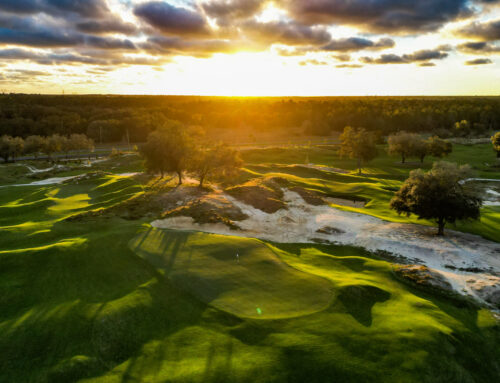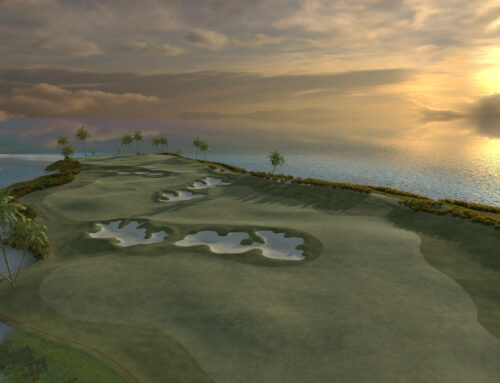Glen Echo Country Club
by Jim Healey
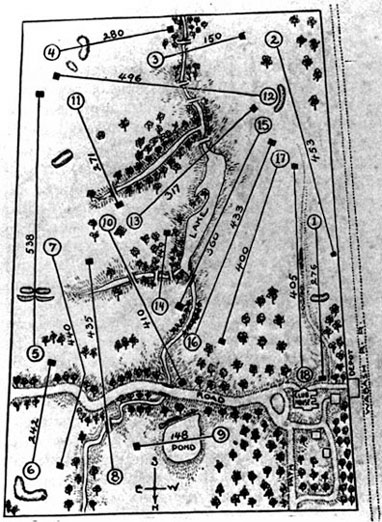
Glen Echo’s routing circa 1904.
Glen Echo Country Club is the oldest private 18-hole course west of the Mississippi and may very well be the oldest 18-hole course, public or private in this area. Opened on May 25, 1901, it was the first course in the St. Louis area designed from its inception with 18-holes. Founded by George McGrew and his son-in-law Albert Lambert – an avid flight enthusiast, he is the namesake of St. Louis’ airport and was president of Lambert Pharmacal (forerunner of Warner-Lambert Pharmaceuticals, now part of Pfizer) Lambert won the handicap trophy at the 1900 Paris golf matches and advanced to the quarterfinals of the 1904 Olympic Golf Matches. He is the only individual to have competed in both Olympic Golf Matches.
Glen Echo played host to the 1904 Olympics, won by Canadian George Lyon when he defeated Chicagoan and Harvard golfer H. Chandler Egan 3&2 in the finals. Egan, the defending U.S. Amateur Champion, had been the heavy favorite to defeat the 46-year old Lyon, but Lyon’s strong driving and Egan’s erratic play combined to doom the 22-year old golfer.
Designed by the 1896 U.S. Open Champion Jim Foulis, and built by he and his brother Robert, Glen Echo is among a handful of great classic courses that have retained the charm and characteristics not found in many of today’s ‘modern’ layouts. Robert would design and/or build over a dozen St. Louis area and midwestern courses, including the original Bellerive CC, Onwentsia in Chicago, Lake Geneva CC, Minikahda, Jefferson City CC, Sunset CC just to name a few. Jim, who was the first golf professional in the western U.S. when hired by C.B. Macdonald at the Chicago GC in 1894, designed such courses as the original St. Louis CC, Denver CC and several in the Chicago area. Born and raised in St. Andrews, Scotland, the brothers were taught their craft by none other than Old Tom Morris as Robert worked in his shop for years and it was Old Tom who gave him his first design contract in the early 1890’s for a nearby club. It was also Old Tom who Charles Blair Macdonald contacted looking for a professional for his new Chicago GC. Old Tom initially recommended Robert, but when he respectfully declined, Jim came in his place. Robert followed shortly in 1895 and his first contract was the nine holes at Lake Forest GC, Onwentsia today.
In 1913, during their tour of America, Harry Vardon and Ted Ray played a 36-hole exhibition at Glen Echo. Despite never having seen the course previously, during their first round, Vardon shot a 71, while Ray posted a round of 69. Each shot par or better for the second round as well.
The LPGA visited Glen Echo in 1954, 1964, with the final event of this era held at Glen Echo in 1970. Winners included Betsy Rawls, Mickey Wright, and Shirley Englehorn. On the amateur side, at the 1940 Trans-Mississippi Ladies Championship, future LPGA Hall-of-Famers Betty Jameson and Patty Berg squared off in the championship match, with Jameson taking the title. Betsy Rawls shot a Ladies course record 67 enroute to her victory in 1954, against a par at the time of 76.
Visitors to Glen Echo are captivated with the conditioning of the course, while find little comfort when dealing with the many uphill approaches to the fast, sloping greens. They will also find that most tee shots and approaches must carry large valleys to reach the target. Many of the greens feature false-fronts that require one to carry to the green, failing to achieve that you risking having your shot roll back off the surface. It also has some strategic par-3’s. The 14th, which has been virtually untouched over the past century, is patterned after the Short Hole 8th at St. Andrews. It features bunkering right and front left, with a significant fall-off too the left. At only 136 yards, the back-to-front sloping green demands accurate shotmaking for a run at birdie, or merely to save par.
Glen Echo plays to a Par 71 at 6,502 yards with the front nine a Par 36 at 3,264 yards and the back 3,238 yards with a Par of 35 with a slope rating of 127. The course rating is 71.0. The front side is deemed a bit tougher than the back, despite having two par-5’s, one definitely reachable by many in two. The course record is 63 and is shared by two professionals and an amateur. The pros were both head professionals at Glen Echo when they posted their score. Dick Shaiper, who posted his round in 1967, and our current head pro, Nash Haxel, who tied the mark in 1992, each shot round of 33-30. In 2002, in the club championship, amateur Tim Mitchell matched their rounds in the first 18 holes of the day, also posting nines of 33-30. The low ‘ringer round’ is 60 and is held by member Jack Powers, a multiple Missouri Senior Amateur Champion, having posted rounds of 30 on each nine.
Glen Echo is a course that, by today’s standards, belies its relatively short yardage. It is an extremely enjoyable course to play over and over. The numerous natural features constantly leave you in places you may not have seen previously, requiring a unique shot virtually each round. Knowledge of the greens often does not save you from an occasional three-putt, while it may allow you that rare birdie as a reprieve.
Hole #1 – Lilac Way – 380 yards Par 4: The opening hole sets the stage for all others and gives you some idea of what to expect at the holes beyond. The tee shot at the first must negotiate a left to right slope if you hope to find the fairway. Accomplishing that you discover that your approach is an uphill tester to a small green that slopes from back to front, and offers you little in the way of safety. Missing right is certain bogey while long could provide even higher scores. The false front stops many a shot, which when struck, leaves the golfer believing it’s pin high! But better to be short than long as chipping below the pin is always preferred. Par here is well received.
The original tee was located just west of the Clubhouse and played 245 yards straight down the fairway. A row of lilac bushes lined the left side of the fairway about 100 yards out, waiting to catch the errant drive and giving the hole its name. A cross bunker 150 yards off the tee felt many a footprint in its day, as players of that earlier era struggled to carry the hazard. The first was lengthened in 1904 to 276 yards and then completely redesigned in 1927. With the new clubhouse, the hole was moved almost 100 yards west and set back some 100 yards and routed as a dogleg playing to the elevated green we know so well. The original first green would have been located in the vicinity of the existing 18th tee box.
Hole #2 – The Valley – 432 yards Par 4: Like the first, The Valley commands a sloping fairway, falling to the right rough. A draw hit into the hillside will find the fairway, offering a middle iron to the generous green. But should you find the rough to the left or to the right, overhanging trees await the approach struck less than perfect. Many opt for a lay-up just short of the green, leaving a pitch and a tough putt for par. However with a fairly level green, a birdie opportunity waits those who have struck two good shots.
A large bunker guarded the left front of this green in years past, making the approach that much more difficult. Always considered one of the more difficult holes on the course, it hasn’t softened through the years.
Take a good look at the green from the teeing area because once you reach the fairway the putting surface won’t be in view. A well-placed drive to the left center reaches one of the few level spots on this very hilly fairway. The tendency is to come up short with your approach, often even adding an extra club! Guarding against the bunker on the front right, many players pull their approach left, leaving a very difficult up and down. Despite the distance, par here is a good score.
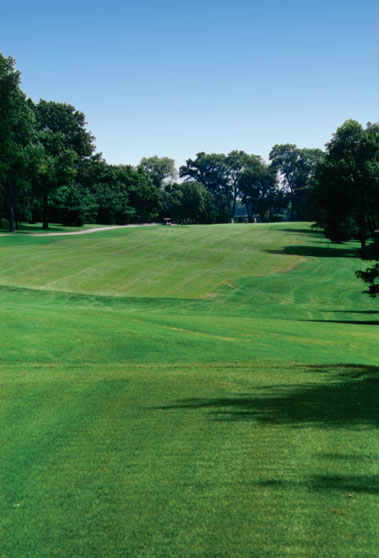
The second
Hole #3 – Spooks – 357 yards Par 4: Originally the hole was split into a downhill par 3 of 150-yards and a 280-yard uphill par 4. This was the configuration played during the Olympic matches and until 1921-22. The original teeing area for the par 3 is near the ladies’ tee today, while the location of the par 4 tee would be in the right rough, just forward of the small wooded area at the bottom of the hill. In all likelihood the par 4 sat a little further back toward the cemetery in the corner area than the hole location today, accounting for the additional yardage.
Hole #4 – Long Drive – 538 yards Par 5:The longest hole on the course, it once played to a length of over 550 yards. With out of bounds right most players have a tendency to end up on the left side of the generous fairway. If you carry the valley off the tee, you can finally see the green and place your second for an easy approach on the third. Hitting into the hill off the tee will leave you with two difficult shots to have a run at a birdie. The large green slopes from back to front, but is somewhat forgiving, making par attainable.
A large cross-bunker sat in the middle of the fairway, about 500 yards off the tee up until the 1920’s, along with several bunkers on the left side between the 4th and the 7th fairways. It was said that Walter Travis, the three-time US Amateur champion, was able to reach the bunker in two when he played here in 1903, but that it was beyond that of most other players, except the very longest.
Hole #5 – Roadway – 277 yards Par 4: Most great courses contain a good, short par 4. The fifth, ‘Roadway’ is such a hole. Low handicappers will test their drive by going for the green, attempting to avoid the bunkers guarding the front. Most will lay-up short and have a short pitch leaving them with a good run at a birdie.
Patience here may be the key for a good score. Trying to get a shot or two lost earlier back here could spell trouble if your tee shot is less than accurate. But the fifth yields more than its share of eagles and birdies for those willing to take the risk. In the Vardon-Ray exhibition here in 1913, Harry Vardon drove the green and sank his putt for eagle! Roadway played as a par-3 during part of its history, but generally has been a par-4.
Hole #6 – The Glen – 176 yards Par 3: Our sixth hole, ‘The Glen’ surrounds itself with a quartet of bunkers – most with deep-set faces – awaiting the tee shot that fails to take into account the swirling wind, or the downhill drop which has many a golfer second-guessing themselves on the downswing! For the well-struck shot left below the hole, a run at birdie is the norm. But with a quick, sloping green your putts from above and to the side often leave you with a large breaking slider that will test your nerves.
‘The Glen’ was added in the redesign that took place during 1921-22. So well does it fit into the flow of the other seventeen that most who play it believe it to be from the original design.
Hole #7 – Boomerang – 468 yards Par 4: The par-4 seventh, ‘Boomerang’ may be aptly named, as this is certainly one hole that may come back to haunt many players! However, it was originally a dogleg left when first opened in 1901, but was moved into a slight dogleg right when the par-3 sixth was added in 1914. Considered one of the best holes in the entire area, even those hitting a great tee shot find themselves with an approach of almost 200 yards. Pondering your second, you view a seemingly tiny green, fronted by two bunkers on either side. Your ball must carry the hill onto the green; failing to do this leaves you a pitch up the hill for a par-saving putt. At 468 yards, and the Number One Handicap hole on the card, a four here is outstanding.
When originally designed the hole played at 330 yards with the green positioned near the bottom of the hill, about 150 yards short of its current location; and the original tee located nearer to the sixth tee as the hole played as a dogleg left. The green was pushed up the hill in 1903, in preparation for the Olympic Matches. It remained with that routing until the sixth hole was added during 1921-1922 when it was converted into the slight dogleg right it plays today.
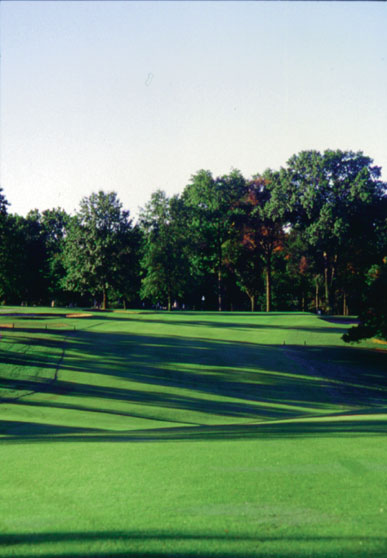
The seventh
Hole #8 – Alps – 472 yards Par 5: The eighth hole, aptly named ‘Alps’ plays the reverse of the seventh, but as a par 5 it gives players a bit of a reprieve – and a chance at par or better. From the tee you view only the tree-lined fairway and large hill which must be carried to have a go at the green. While the hole is reachable by many you must be below the pin with your approach. A severe downhill putt awaits those who lay above the hole in three-putt area! A lay-up into the hill fronting the green and pitch short of the flag should leave you a good run at a birdie.
On opening day ‘Alps’ played as a 345-yard par 4. The tee was located at the bottom of the hill, almost fifty yards in front of the current teeing area. From this location most players could drive over the hill; leaving many with ‘hanging lies’ for their approach. Believing this was not the best form, the tee was moved back in 1903 and converted to a par 5. It has played as long as 479 through the years.
Hole #9 – Fountain – 164 yards – Par 3: The prettiest hole on the course, the ninth hole ‘Fountain’ is only a short to mid-iron over water to a generous, but well-bunkered green. Don’t be distracted by the lovely floral that fronts the lake or the light which sparkles in the mist from the fountain. Pay attention to the wind, and know your distances or be prepared to pay the price. Come up one club short and you find the front bunker or, more painfully, the water, making par a doubtful task. But even with the proper club selection attention must be paid to the pin location. With several hole areas on the green, finding the one without the flag brings a three putt into the picture as undulations and sharp, slippery slopes must be negotiated.
The hole has always played at the same approximate distance. During the Olympics, both Egan and Lyon managed well here, though Egan won the hole during both rounds, with a two! Playing virtually the same for almost 88 years, the green was redone in 1989 adding bunkers to the existing grouping that surrounds the green.

The ninth
Hole #10 – Hard Scrabble – 510 yards Par 5: From the back tees, the tenth demands a long, straight drive that must be squeezed between the narrow opening created by the canopy of surrounding trees. It must also carry the lake 160 yards off the tee to find the sharply sloping fairway. Many players find themselves on the lower right side of the fairway; while others aim left and often find the adjoining rough, forcing a certain layup to the hill fronting the green. A well struck drive, with a slight fade to it, may find the center of the fairway, and give you the best opportunity to have a go at the green. Carrying the ‘false front’ to the green is a must for a run at eagle. However, a pitch from below the pin will leave you a short uphill putt on this small flat green.
Originally negotiated at 400 yards, the hole was noted for the deep ravine at the bottom of the hill below the green, from which there was no recovery. Chandler Egan found this in the final match, and it contributed to his defeat. The hole was lengthened to 420 yards in 1905 and then to its current length in 1928.
Hole #11 – Hillside – 244 yards Par 3: ‘Hillside’ is the name for the eleventh. It may be the easiest par four on the course…unfortunately it’s a par-3! At 241 yards, your tee shot must carry two hills; avoid going right to almost certain bogey, and land gently to hold the green. A rather daunting task. A driver for many players, most aim left, and if they miss the putting surface, facing a delicate pitch in hopes of saving par.
In 1901 the hole played as a 265 yard par 4, as the teeing area was back slightly toward the tenth green. It was lengthened to 271 yards in 1903 and remained there until 1928 when it obtained its current length following the redesign.
Hole #12 – Westward Ho – 406 yards Par 4: Another of the great strategic par 4’s at the Club, ‘Westward Ho’, the twelfth, offers many options off the tee. You may drive down the right side, leaving a lengthy uphill second, or take the more bold approach from the tee and fly it over the corner of the large trees, with a slight draw, cutting-off substantial yardage, while attempting to land at the bottom of the hill and find a level lie. Others, even more daring, attempt to carry the heart of the trees to the left, tempting the golf gods to spare them the agony of a ball clanking off a distant limb. Achieving the latter, it’s only a short iron approach to this small, uphill green. However, failing to reach the bottom leaves you with a downhill lie and an uphill shot to the green…no easy task.
Initially a 355 yard par 4, it was lengthened to a 496 yard par 5 in 1903 and remained at that length until the late 1920’s when it was set at its current routing. A bunker at the rear of the green adjoined the second fairway as it caught balls hit long to Twelve or hooked toward the Second. The creek which ran through the course was located at the bottom of the hill fronting the green, further adding to the holes difficulty as bold tee shots often found water instead of the fairway.
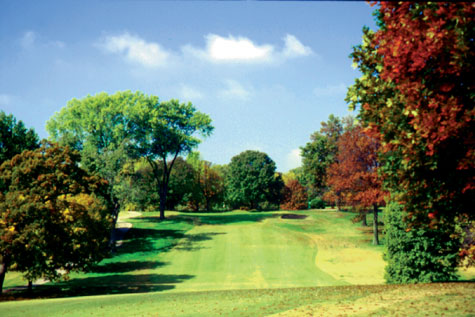
The twelfth hole
Hole #13 – Echo – 353 yards Par 4: The thirteenth requires shotmaking similar to the third hole. Your tee shot must carry a steep valley and will leave you an uphill approach to a small, sloping green. The sharp rise and small green result in many players coming up a club short – while insisting the shot was perfect! But with the proper club and good direction, a run at a birdie is a real possibility as the green is fairly level. If putting uphill. However, a sidehill approach will leave you with a very delicate putt. A missed tee shot to the left is almost certain bogey as the many trees which line that side of the fairway seemed destined to catch the wayward shot, while the right rough offers a slightly better opportunity to salvage par.
The lake originally extended across the bottom of the hill, and continued through the 12th and 3rd fairways. Carrying this with your tee shot, the 280-yard hole had a large cross-bunker in the fairway short of the hole to catch the poor approach. Lengthened to 317 yards in 1903 it remained that length until the late 1920’s when it was lengthened as ‘Westward Ho’ was re-positioned and a new tee added to ‘Echo’.
Hole #14 – Dewdrop – 136 yards Par 3: Playing straight downhill to a small green of only 2,700 sq. ft., the fourteenth, ‘Dewdrop’ is rated as the easiest hole on the course. But the size of the green, as well as the bunkering, provide fairly severe penalties for the errant shot; as well as quick rewards for the one well-struck. Miss to the left and a bogey or worse will surely be the result. A deep bunker front left, a pot bunker to the back and a cop bunker to the right, define the surface, leaving you little room for error. But once on the putting surface the ball seems to Ëœfunnel’ toward the hole from almost every direction, leaving a great opportunity for birdie.
The hole has changed little since opening day, with only bunkers added over time. In the 1921 and 1922 events, when the order in which the holes were changed, Dewdrop played as the 16th hole in the rotation. The 17th, which no longer exists as it was, played as the 10th, with the 18th playing as the 11th. The players then made the short trip to the today’s 10th which was their 12th of the day and the matches were to end on the 16th.
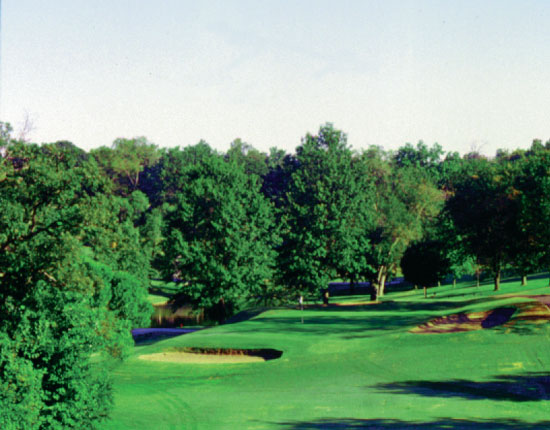
The fourteenth hole
Hole #15 – The Lake – 360 yards Par 4: ‘Playing down the right side of the fairway, the proper side, the player is left with only a short iron into the green.’ Taken from an early course guide, what it doesn’t mention is that finding the left side of the fifteenth fairway will almost certainly find the water just beyond! If you’re fortunate enough to stay dry in the rough to the left, your approach must negotiate the right to left slope and the large apron fronting the green, which gathers even well-struck shots and leaves them short of the putting surface. The green slopes sharply from back right to front left so a two putt here is never a certainty. Despite its relatively benign length on the card, the fifteenth is one of the most challenging and difficult holes on the course.
The Olympic matches were decided here when Egan drove into the ‘Lake’ and opened the door for Lyon’s eventual victory. In 1922, Blanche Sohl also dunked her tee shot, allowing Marguerite Gaut to win the Women’s Western Amateur on this hole.
With the tee initially more forward, the hole played at 280 yards. It was moved back in 1903 to the vicinity of its present location and measured at 360 yards. A new green was also constructed that season as the original had such severe undulations and slopes that members found that even a well-played shot found its way off the surface.
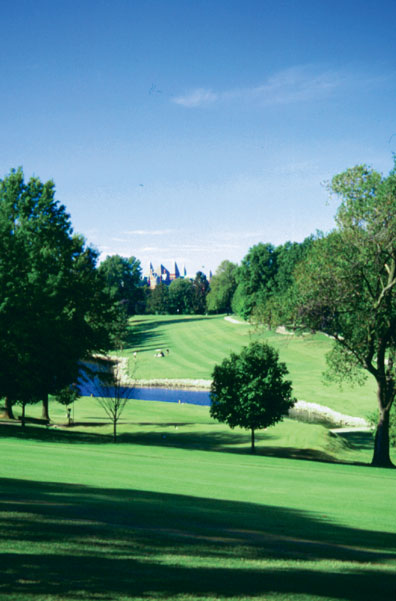
The fifteenth hole
Hole #16 – Punch Bowl – 434 yards Par 4: Like the seventh, ‘Punch Bowl’, the sixteenth, is one of the most challenging holes in the area. At 432 yards, this dogleg left has the length to hold up to the best players; but it’s the routing of the hole, the position of the trees and the difficulty of the green, which combine to make it one of the toughest. A tee shot played to the right center of the fairway leaves you a mid-iron to a tiered green, and that’s where the fun begins. A flag set on the lower level location will find many approaches landing short and rolling back some 30-40 feet into the fairway. If your approach is long to the upper tier, your eventual putt could well end up in the same location off the green. Sixteen will challenge your nerves as well as your golfing skills. A back flag is preferred by most players as the uphill putt is preferred to coming the opposite direction.
The hole was originally a fairly straight, downhill par 4 of about 430, with the green located near the lake, and perhaps even where part of the lake is today, to the right of the present green. During the redesign of 1927-28 the green was moved to its present location and routed as a dogleg left with bunkers added to the front left. It was here in 1940 where Betty Jameson closed-out Patty Berg in winning the Trans-Miss title 3 & 2. Many of the trees on the right side of the fairway have been planted within the past 50 years.
A seemingly benign hole from the card, its length belies the tough approach shot to the green. The downhill shot must find the fairway if you are to negotiate the bunker short of the green. From the rough left or right, a recovery shot will find holding the green very difficult, assuming you carry the deep bunker, and you will be left with a challenging recovery and a putt for par.

The sixteenth green
Hole #17 – Old Hickory – 384 yards Par 4:The seventeenth was one of the holes that underwent complete renovation in 1927-28 when the original clubhouse was razed and the current building constructed. Originally a 365-yard par 4 it was lengthened to 400 yards for the Olympics and stayed that length until 1928. With the new clubhouse being built several holes were re-routed and a few added. ‘Old Hickory’ had played from a tee set near the original 16th green. At that time the 15th, 16th and 17th holes shared a single, very wide fairway, with the green for the 17th situated near the nursery behind the 17th green today, just to the left of the 16th tee. The 17th hole today traverses the original 18th hole in the opposite direction, and is a bit shorter. The bunker fronting seventeen was added in the late 1940’s.
Hole #18 – Sweet Home – 411 yards Par 4: ‘Sweet Home’ offers visions of safety, but little is found on this terrific dogleg par 4. With large trees lining the fairway you’ll require a well-struck tee shot to finds the smooth zoysia grass, leaving a mid-iron into the putting surface. When the wind is swirling atop the trees, you had best pay attention to it or your approach will find one of the bunkers that surrounds the front and sides of this sloping green. Par here is indeed sweet, as it will make a fine ending to an enjoyable round.
The eighteenth originally ended on the south side of the Victorian Clubhouse, just to the left of the 17th tee today. With the demise of the clubhouse in 1928 a new routing was added to accommodate a new closing hole and the 18th was moved almost 100 yards west to its present location. Originally paced at 355 yards, 50 more were added for the 1904 Matches. The hole played uphill to the green, placing the location of the original tee in the vicinity of the nursery behind the 17th green. At 405 yards, it would have been quite a hole! It was here in 1913, according to newspaper accounts of the day, that Ted Ray, using an iron, drove his tee shot 310 yards uphill with the wind! The green was quite large, covering almost 10,000 square feet. Sitting just to the right of the green, near the trees, was the areas first putting green, a 100 x 300 foot surface with 9 holes. The surface was lighted for night play with lights hung from posts and in the surrounding trees and was visible from members seated on the veranda.
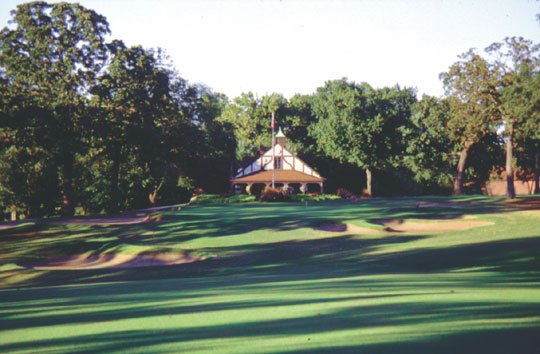
The finishing hole
The End


